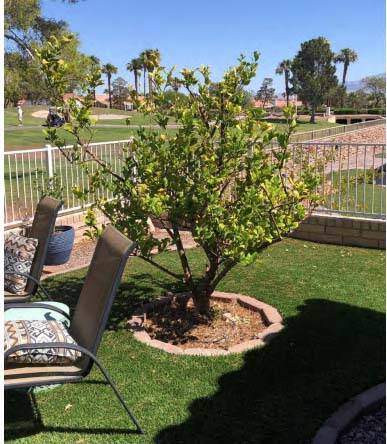Bay laurel trees struggle with hot temperatures
Q: Our sweet bay laurel trees face east and are watered by a drip irrigation system on a separate line for trees only. Obviously, these trees are not doing well. They were originally 24-inch boxed trees planted in 2013. Our HOA contends they are close to the end of their lives, and they will be removed. Any ideas?
A: From the photo you sent, the leaves exposed to the heat of the sun are scorching along the edges. This means not enough water is getting to them either because there is not enough water supplied to the trees or there is damage to the trunk or limbs.
Bay laurel trees struggle when temperatures are very hot and there is very low humidity. Particularly if it is windy. They are treated like desert trees, but they are not. They are a mesic tree, not xeric, coming originally from the Mediterranean area of the world, and not a true desert tree like palo verde, desert willow, Texas mountain laurel or any trees native to our Southwest deserts.
Big trees use more water than smaller trees. As trees get larger, they require more water. As these trees get larger, more drip emitters must be added to give them the water they need.
You could increase the number of minutes, but then everything on that line or valve would get an increase in water as well. There are other alternatives, but adding more drip emitters is the most common.
I would guess trees would need more water applied (change in the water applied) every three or four years until they reach maturity. It is better to add drip emitters to those plants getting larger than just adding more time; either is a challenge for HOAs as the cost of water increases and they are still trying to contain costs.
There are three ways to reduce their need for water: 1) reduce the size of trees and other large plants; 2) reduce the total number of trees and shrubs; and 3) change over to desert native plants like I mentioned previously.
Irrigation is a human landscape management tool. Changes in irrigation management, as well as monitoring water applied to the soil, must be done by the landscapers.
In the desert, all plants use water. With these tree losses, think of ways to beautify your landscape that does not include plants (water). We cannot have a landscape full of trees and shrubs in the Mojave Desert. Those plants used must have a purpose.
Q: I have emailed you before about having only one watering zone. Our lemon tree seems to be doing worse every year. With only one irrigation zone, unfortunately, I am forced to water every day in the summer. We decided we should water these citrus trees by hand. So, we have two questions: how much water per watering and how often?
A: Looks like fake grass was installed surrounding the tree. This may be a problem in future years because of numerous soil problems, primarily air reaching the tree roots and compaction from people walking near it.
Pull the fake grass away from the tree to the size of the canopy. It is important that plant roots breathe air. Some types of fake grass are better at that than others. Make sure enough air is getting to plant roots.
Start watering this tree now with about 15 gallons each time (judging its size from your picture). As the tree increases in size, it needs more water; probably about every three or four years, the area under the tree canopy will need to become bigger to give it this.
The tree will max out at about 30 gallons each time it is watered. When an increase in water is needed, remove more grass to accommodate the amount of water applied. The easiest way to give the tree more water and keep it from falling over will be to increase the size of the area where water is applied.
Use a moat or doughnut-shaped basin around the tree for filling each time with a hose. The basin, and the inside being flat, will hold water long enough to get it deeper into the soil. If the tree does not have a moat or doughnut around it, it is difficult to put enough water in that spot to wet the soil 18 inches deep each time.
Just putting a hose on it will not work unless you water with a sprinkler or let the hose run slow for a long time. Using a moat or doughnut will fill the basin with water in about ten minutes or less and keep it contained.
Q: About two weeks ago, I noticed a strange growth at the base of several different plants. The largest was about 4-by-6-inches and shaped like a smooth, white, used bar of soap — slightly moist and slippery on the outside and like a semi-hard cheese on the inside. It seemed like it was attached to the soil but was also around the stems and branches that came out of the ground. It broke into slightly smaller pieces as I worked it out of the soil. What is it and what do I do to remove it?
A: Without a photo it is difficult to tell, but it sounds like it is slime mold. Search it out.
Slime mold is a type of fungus or mushroom that does not cause problems for plants. It is what is called a saprophyte and feeds on moist or wet dead wood or woody debris. It feeds on the rotting wood below the surface of wet soil.
We see that often in soils covered in wood chips or woody compost used for enriching the soil, buried rotting wood in the soil and even dead or dying roots. It is a plant that is a decomposer.
Use a shovel, pick it up and put it in the garbage so the dog or kids don’t get into it. No other treatment is necessary. One person reported a rash from it, so be careful in case you are in this minority.
Q: What is wrong with my orange tree? It has lots of oranges, but the tips of the trees are dying in some places.
A: It is probably either an insect or disease problem.
First, I would open the canopy of the tree a bit more by reaching inside of it and pruning the limbs at a joint (where they come together) and remove one of them to make the canopy of the tree more open. That will help air circulation, a critical factor for disease control. In some cases, it can remove disease problems when humidity and air movement are factors.
Secondly, after the canopy is more open, I would look at the damaged areas. If you bend the branches that remain, you can determine if it is an insect or disease problem. The insects will weaken the branches just below the damaged areas and break. Diseases will not unless the area is dead. Look for insect damage or disease problems just below the dead or dying areas.
Sorry, but there may not be any chemicals of use. Just plant management or wait.
Q: A few branches on one of my peach, peach, plum and loquat trees have died, and the fruit on these branches have shriveled up and fallen. When the branches began to dry up, I reacted promptly by adding more compost and mulch to the tree and ensuring it is getting enough water. Unfortunately, the branches continued to dry and now appear dead. After lots of research, my best guess as to what is killing these trees is grubs. I have found many in my soil and often see lots of Japanese beetles in my trees. I am curious if there is anything I can do to prevent the leaves from frying in the hot Las Vegas sun.
A: I am guessing they have borers, causing the limbs to die and the fruit to shrivel. Doesn’t sound like grubs but rather borers are in the branches of the trees.
Pick up a borer-control insecticide that is applied to the soil and apply it now. Follow the application directions and precautions printed on the label. By the way, we don’t have Japanese beetle yet in Southern Nevada.
Make sure the soil surrounding these fruit trees is covered with wood chips and not rock. Make sure your fruit trees are getting enough water at each irrigation: 5-gallon fruit trees should get 3 to 5 gallons of water, and 15-gallon fruit trees should get about 12 to 15 gallons of water.
Every three to four years, they will need more water because they are larger. Fruit trees grow best when surrounded by other plants. The maximum amount of water for fruit trees trained for easy picking is about 30 gallons and spread over an area at least half the size of its canopy. This irrigation water can be applied in either a basin/moat/doughnut surrounding the tree or by drip irrigation.
Loquat is more susceptible to heat and borers than the other fruit trees you mentioned. Make sure it is planted on the east or north sides of a building. Other fruit trees will grow better in the heat than loquat if planted at least 5 feet away from hot reflective walls.
Bob Morris is a horticulture expert and professor emeritus of the University of Nevada, Las Vegas. Visit his blog at xtremehorticulture.blogspot.com. Send questions to Extremehort@aol.com.





























